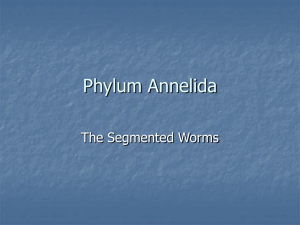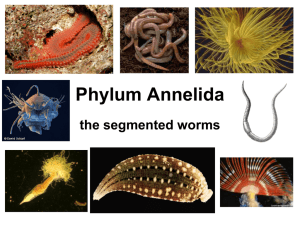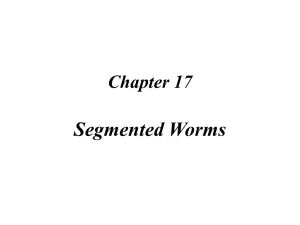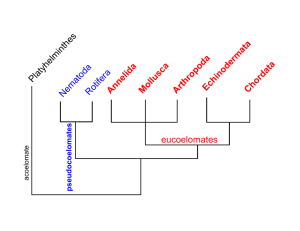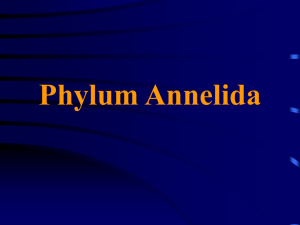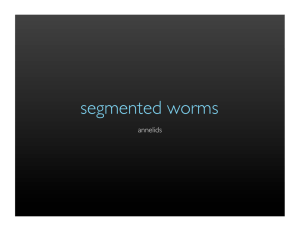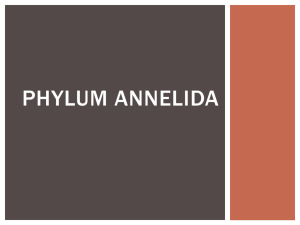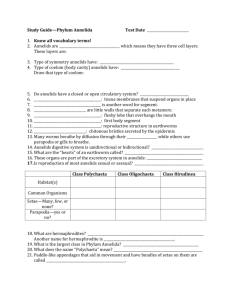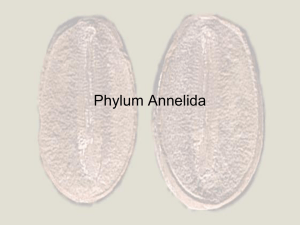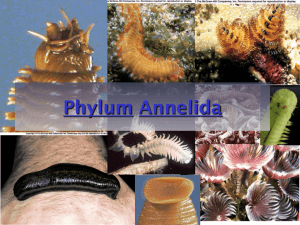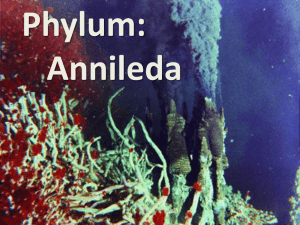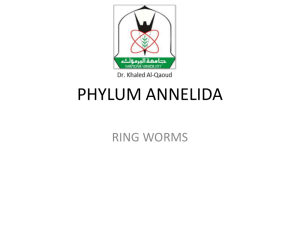Major Divisions of Life
advertisement
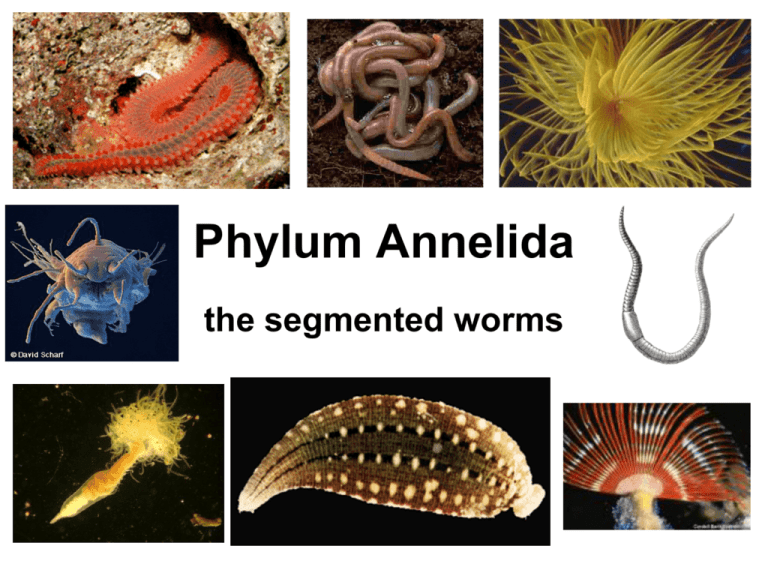
Phylum Annelida the segmented worms Activities and Assignments • Labs – Earthworm behavior (binder) – Earthworm Dissection (binder) • • • • • Video Med. Uses of Leeches (binder) Quiz- short topic Text Reading 671-674 Worksheet Vocabulary: monecious, dioecious, mutualism, tagmosis, detritus, triploblastic, coelom, septa, cerebral ganglia, parapodia, setae, parts of the worm anatomy from the lab How do the Annelids fit in? Rotifera Nematoda Platyhelminthes Cnidaria Porifera unknown common ancestor Nemertea Annelida Annelida Characteristics Triploblastic (3 tissue layers) Organ level of organization Bilateral Symmetry Cephalization Coelomate (with a body cavity) Remember these ideas from the last chapter Coelomate Have a “true” body cavity that is completely surrounded by mesoderm ectoderm coelom mesoderm Gut endoderm Annelid Characteristics the coelom • is a closed, fluid filled cavity that ectoderm surrounds the gut • the fluid within acts as a circulatory system and hydroskeleton • mesodermal membranes (mesenteries) suspend organs in the coelom Annelida Characteristics Metamerism The body is made up of serially repeating, coordinated segments called metameres that are separated from one another by septa. •Each metamere contains sets of repeating organs e.g. gut, blood vessels, nerve cord, excretory organs Metamerism septa Think of a row of tires Annelida Characteristics Nervous system • 2 cerebral ganglia • a ventral nerve cord with 2 ganglia per metamere. • In some species, sensory organs such as eyes, palps, and tentacles have arisen brain 2 cerebral ganglia nerve cord Annelida Characteristics Arthropod exoskeleton Locomotion component • both longitudinal and circular muscles • most have setae (chitonous bristles secreted by the epidermis) that aid in locomotion and burrowing Skeletal System • fluid in coelom acts as a hydrostatic skeleton Class Oligochaeta Locomotion Circular muscle contraction Longitudinal muscle contraction Annelind Cross section Annelind Cross section Circular muscle Longitudinal muscle skin Annelind Cross section coelom Gut (intestine) Intestine wall skin Circular muscle Longitudinal muscle Annelid Characteristics Gas exchange • mainly by diffusion • Class Polychaeta often has specialized structures for gas exchange (e.g. parapodia, gills) Annelid Characteristics Digestive System • complete • regional specialization You’ll get to observe these more closely during the dissection Circulatory System • closed circulatory system composed of blood vessels (some of which are contractile and act as “hearts”) • some circulation is also accomplished by the coelomic fluid coelomic chambers pharynx mouth esophagus This diagram is found in the dissection lab crop (storage) gizzard (mashing) More properly called “aortic arches” hearts One each on the dorsal and ventral sides blood vessels Annelid Characteristics Excretion • excretion is accomplished by organs called nephridia (singular nephridium) in the skin Reproduction • sexual •Hermaphrodites (individuals with both sets of reproductive organs) Phylum Annelida Class Oligochaeta Class Hirudinea Class Polychaeta Class Oligochaeta Class Oligochaeta • terrestrial, freshwater and marine • have few setae (Oligo = few, chaeta = setae) • usually feed on detritus (decaying organic matter) • have specialized digestive system to obtain the maximum amount of nutrients out of the detritus (e.g. pharynx, gizzard, crop…) Class Oligochaeta Locomotion Circular muscle contraction Longitudinal muscle contraction Class Oligochaeta Reproduction • usually monoecious • cross-fertilize by exchanging sperm clitellum testis Ecology • Earthworms are essential soil aerators • If all the material ever moved through earthworms was piled up, the heap would rise 30miles , more than 5 times the height of Mount Everest!! • Worm Grunting: A saw or leaf spring of a pick-up stob Class Hirudinea Class Hirudinea • usually freshwater but there are some marine and terrestrial species • no septa between metameres • no setae • have 2 suckers Class Hirudinea • have an extendable proboscis for feeding Class Hirudinea • usually have a fixed number of segments (34) • each metamere consists of several annuli (think accordion) 1 metamere annuli Class Hirudinea Locomotion Lack septa between metameres, so they are incapable of moving like Oligochaetes. Instead, they use their anterior and posterior suckers to move. Class Hirudinea Reproduction • usually monoecious • cross-fertilize by exchanging sperm Ecology • Although some leeches are parasitic blood suckers (can be temporary or permanent), many are predators. Ecology video • Leeches have been used medicinally since the 19th century. • Currently they are used to increase blood flow following reconstructive surgery • Hirudin is a powerful anticoagulant that is found in the salivary glands of leeches •Leech saliva contains antiseptic chemicals •And an anesthetic DON’T WRITE THIS DOWN, YOU HAVE AN ARTICLE AND VIDEO WITH THE INFO Class Polychaeta Class Polychaeta • all marine • this class contains 2/3 of all known Annelids • have a well developed head with specialized sense organs Class Polychaeta • have many setae (chitonous bristles secreted by the epidermis) (Poly = many, chaeta= setae) • these setae are arranged in bundles on paddle-like appendages called parapodia setae Class Polychaeta Parapodium setae The parapodia function in gas exchange, locomotion, and feeding. Class Polychaeta Tagmatization (tagmosis) • the fusion and specialization of formerly metameric segments Class Polychaeta Many are filter-feeders with specialized structures Class Polychaeta Many are predatory with specialized structures Class Polychaeta Many construct their own homes out of CaCO3 or sand debris and mucous Ecology • Polychaetes often have effective defense strategies: • some have tubes to hide in • some have vicious jaws • some have modified “stinging” setae a fireworm Segmented Worm Quiz on • Topics – Phylum Annelida and 3 classes – General Characteristics and Examples of each – Vocabulary: monecious, dioecious, mutualism, tagmosis, detritus, triploblastic, coelom, septa, cerebral ganglia, parapodia, setae, parts of the worm anatomy from the lab • Labs – Earthworm behavior (binder) – Earthworm Dissection (binder) • • • • Video Med. Uses of Leeches (binder) Quiz- short topic Text Reading 671-674 Worksheet
